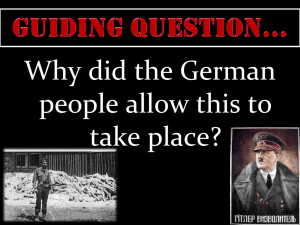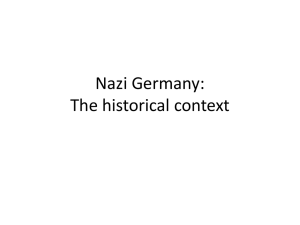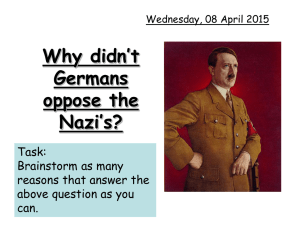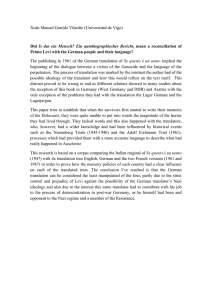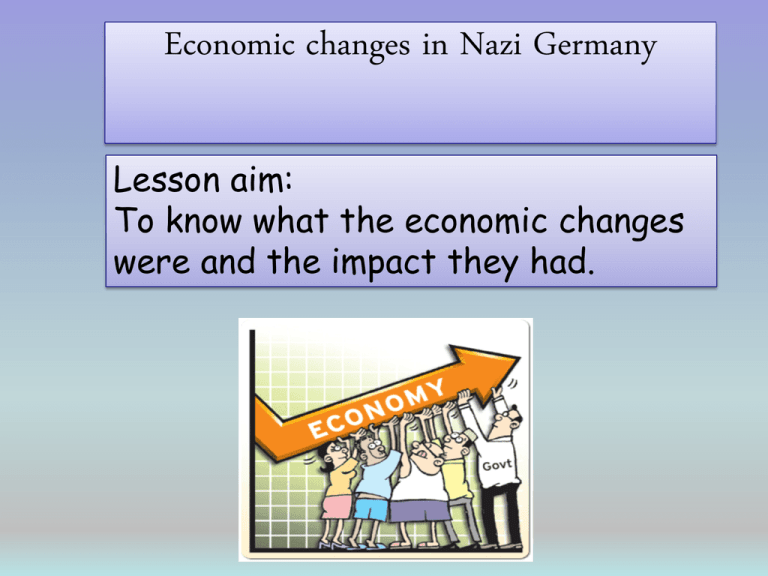
Economic changes in Nazi Germany
Lesson aim:
To know what the economic changes
were and the impact they had.
Learning objectives:
• I will be able to describe Nazi attempts
to reduce unemployment. (C/D)
• I should be able to explain Nazi
economic policies. (B/C)
• I could also be able to evaluate if
Germans were better or worse off in
the Nazi state.(A/B)
Key words
Autarky: self sufficiency
Autobahns: German motorways
Invisible unemployed: the unemployed not
counted in official figures
Real wages: wages adjusted to allow for
inflation
Rearmament: Building up armed forces
and weapons
Key words
‘New Plan’: introduced by Dr Schacht, President of the Reichsbank
Four Year Plan: Goring, a leading Nazi, his plan was intended to
prepare Germany for war in 4 years and was linked to autarky.
National Labour Service (RAD): compulsory for men aged between
18 and 25 – built autobahns etc.
The Labour Front (DAF) replaced trade unions – ran the Beauty of
Labour and Strength through joy schemes for workers.
Strength through joy: provided workers with activities in their
leisure time
Beauty of Labour: main task to improve working conditions.
Volkswagen: the people’s car - a savings scheme was introduced to
enable people to buy the car.
Getting an overview
The Nazis were determined
to reduce unemployment
and build up the German
armaments industry in
readiness for a future war.
Getting an overview
1933: job creation schemes - autobahns
1934: many women forced to give up jobs
1935: National Labour Service - compulsory
1936: Many Jews forced from jobs
1937: Rearmament programme begins
1938: More than a third of spending on
rearmament
1939: German army increased to 1.4 million
REARMAMENT
SELF SUFFICIENCY
(autarky)
Nazi economic policies
Schacht and the New Plan
Dr Schacht was made
Minister of the Economy
in 1934. His aims were
to:
Reduce unemployment
Make Germany self
sufficient (autarky)
He was removed from his
job in 1937.
REARMAMENT
SELF SUFFICIENCY
(autarky)
Nazi economic policies
Goring and the
Four Year Plan
Goring was a leading Nazi who
took over economic policy from
1936.
His four plan dealt with preparing
Germany for war.
The whole economy was geared
towards rearmament and autarky.
The Four Year
Plan
Propaganda poster
encouraging workers
to help in the
struggle for autarky.
It says:
‘Help Hitler build.
Buy German goods’.
How did the Nazis reduce
unemployment?
Remember Hitler had
promised to sort out
unemployment
Unemployment in
Germany 1933 -39
7000000
6000000
5000000
4000000
3000000
2000000
1000000
0
Series1
1
2
3
4
5
6
7
1933
1934
1935
1936
1937
1938
1939
3,773,000
2,974,000
2,520,000
1,853,000
1,052,000
302,000
Series2 6,014,000
How did the Nazis
reduce
unemployment?:
Job creation
schemes
German
autobahn built
by the Nazis
How did the Nazis reduce
unemployment?
National Labour Service (RAD)
From July 1935 it was compulsory for all
men 18-25 to serve six months in the RAD.
The men built autobahns and other large
scale building projects.
This removed millions from the
unemployment figures.
The RAD was not popular.
How did the Nazis reduce
unemployment?
Invisible unemployment:
Women and Jews were forced out of jobs
Men aged 18-25 had to join the RAD
Opponents of the Nazis were sent to
concentration camps.
NONE OF THESE DID NOT COUNT IN
OFFICIAL UNEMPLOYMENT FIGURES.
How did the Nazis reduce
unemployment?
Rearmament:
The four plan meant the economy was
geared to preparing for war.
Rearmament created many new jobs as
billions were spent on making weapons.
In addition the army forces were built up,
this took more the a million off the official
unemployment figures.
How did the Nazis
reduce unemployment?
The DAF (German
Labour Front) was a
massive organization
formed to control the
workers. Everyone had
to join.
It put people to work on
building the autobahns,
hospitals, schools and
other public buildings
This poster links the German Labour Front
(the DAF) to World War I. The point is that just
as soldiers were comrades regardless of their
standing in civil life, so too all German workers
were comrades in the DAF, regardless of
whether they were white or blue collar. This
appeared in 1933..
3740 hours
Dr Robert Ley was
given the task of
filling German
people’s spare time.
He was in charge of
the German Labour
Front (DAF)
Why do you think this
was so important?
Dr Robert Ley
The standard of living of German workers
Between 1936 and
1939 wages increased
because of longer
working hours. So
people worked longer
for the same money
before the Wall St
Crash.
Also the cost of living
went up in the 1930’s.
This meant real wages
actually fell.
There were also food
shortages.
The standard of living of German workers
Trade unions had been
banned by the Nazis.
They were replaced by
the German Labour
Front (DAF) led by Dr
Ley.
It was compulsory for
workers to join.
The DAF ran two
schemes:
Beauty of Labour
Strength through Joy
Both were designed to
keep the workers
motivated and happy.
The standard of living of German workers
The KDF – ‘Strength through joy’ kept
workers happy by providing them
with leisure activities.
Strength through Joy
Programmes included:
1. Cheap walking and skiing holidays
2. Outings to the opera and theatre
3. Adult evening classes
4. Savings schemes to help people buy a car-VW –
People’s car.
• What can you learn
from this source
about Dr Ley’s
Strength through
Joy programme?
The standard of living of German workers
The Beauty of Labour was another branch of
the German Labour Front.
It was designed to improve working conditions and
provide better facilities for workers such as
canteens and swimming pools.
However, as workers were expected to make
these improvements in their spare time the
scheme became unpopular with many workers.
The standard of living of German workers
The Volkswagen
This poster from around
1939 advertises the
Volkswagen. The text:
‘Save 5 marks a week
and you will drive your
own car.’
By the start of the war
not one car had been
bought and no money
was refunded.
How well off were other groups?
Farming communities:
Farmers benefitted from a rise in food prices but suffered a
shortage of labour and workers left for better jobs in the
city.
Small businesses:
Received support from the Nazis. Curbed influence of
large department stores.
Big business:
Really benefitted. No threat from trade unions and strikes.
Rearmament meant growth and larger profits. Huge
government contracts were given.
How successful were Nazi economic policies?
Look at pages 128 – 29 in white book
In groups you will each analyse one graph
and then feed back to the class your
findings.
Afterwards you will need to consider
these findings in order to answer this
question.
(Try to remember previous economic
events in Germany)
How successful were Nazi economic policies?
•
•
•
•
•
•
•
•
•
•
•
Debt – had risen under the Nazis
Investment rose to pre depression rates by 1936
Autarky – Germany still imported more than they exported.
German production did increase especially heavy industries like
iron and steel
Jobs created by rearmament programme
Unemployment dropped
In 1938 wages in real terms were not much higher than in 1928
Working conditions may have improved with schemes like the
Beauty of Labour and Strength Through Joy.
Working hours increased from average of 40 to 60 a week
between 1933 and 1944
Industrial accidents rose by 150% between 1933 and 1939
Big business no longer had to worry trade unions and strikes.
Were German people better or worse
off under Nazi rule? (LO3)
YES
MOST GERMANS WERE NOW IN
WORK
NO
TRADES UNIONS WERE
ABOLISHED – WORKERS HAD FEW
RIGHTS
Can you add to the table?
Summary
• The Nazis were determined to make Germany selfsufficient. Schacht began a policy of autarky. This
was continued with Goring’s Four Year Plan.
• Unemployment was removed in the years 1933-1939
through rearmament, the Labour Service and ‘invisible
unemployment’.
• In some respects workers were better off under the
Nazis because of Beauty of Labour and Strength
through Joy.
• In some respects they were worse off because of the
banning of Trades Unions and the Volkswagen swindle.
Worcesterjonny clips
Four year plan
http://www.youtube.com/user/worcesterjonny#p/c/C5037E7D433E2AF
E/33/qvGBu1M1kQk
How Nazis reduced unemployment
http://www.youtube.com/user/worcesterjonny#p/c/C5037E7D433E2AF
E/32/IQUW4n5gBwc
Were the workers better off under the Nazis?
http://www.youtube.com/watch?v=l2z1VWvbzUM
Useful links
•
•
•
•
•
http://www.historygcse.org/
http://www.schoolhistory.co.uk/lessons/germany/economy.html interactive
diagram
http://www.johndclare.net/Nazi_Germany3_Gunsnotbutter.html
http://www.schoolhistory.co.uk/gcselinks/indepth/germany/resources/unemp
loyment.pdf
http://www.schoolhistory.co.uk/gcselinks/indepth/germany/resources/Autark
y.pdf




